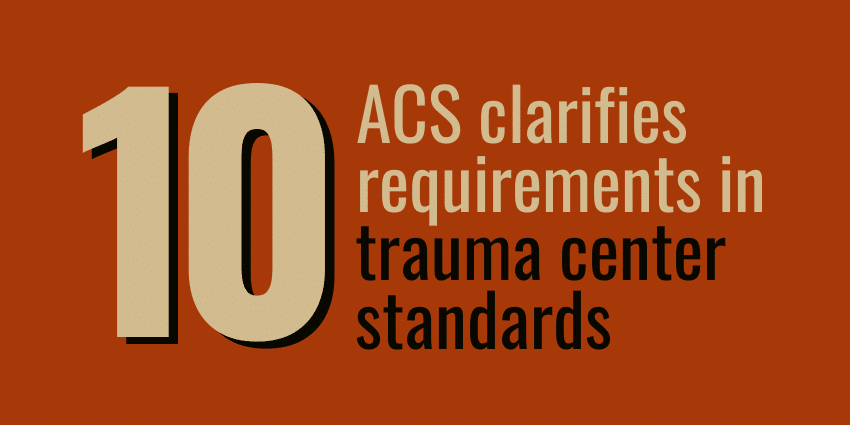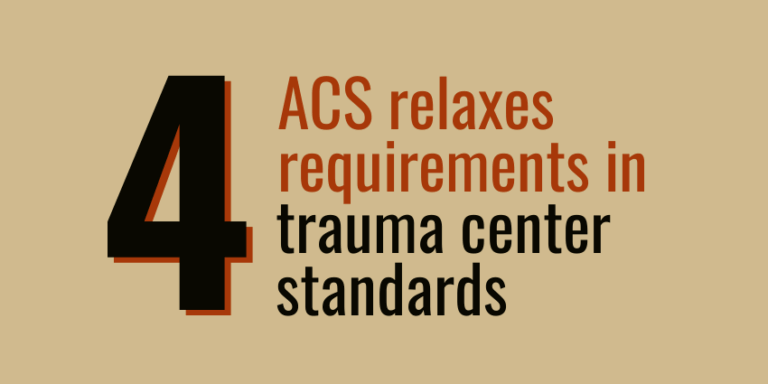The American College of Surgeons (ACS) recently released the third update of Resources for Optimal Care of the Injured Patient: 2022 Standards.
The new July 2025 Revision of the resources manual relaxes several trauma program requirements in four separate standards. According to the ACS, the changes are effective immediately.
More leeway in ICU physician coverage
Previously, Standard 4.17 specified that the ICU must be staffed with physicians “whose primary responsibility is to the ICU.” It further specified that these physicians can be “residents, fellows, or attendings.”
The July 2025 update to this standard has relaxed these requirements.
- Standard 4.17 no longer requires that the ICU be staffed by physicians who are primarily responsible to the ICU.
- In addition, the standard now specifies that the ICU coverage requirement can be met by advanced practice providers (APPs) as well as physicians. In keeping with this change, the title of this standard has been changed from “ICU Physician Coverage” to “ICU Clinician Coverage”.
Trauma program leaders should note that the updated standard now includes tighter language around clinician response. The phrase “continuously available within 15 minutes of request” has been replaced with “continuously available to respond at bedside within 15 minutes of request”. [emphasis added]
This standard applies to all Level I and II adult and pediatric trauma centers.
(More resources: 3 strategies for improving documentation of specialist response to trauma)
“Contingency plan” now accepted for ophthalmology coverage
Previously, Standard 4.22 required Level I and II trauma centers to ensure the continuous availability of ophthalmology services.
The July 2025 update of this standard now states that centers can achieve compliance through either continuous availability of ophthalmology or “a contingency plan to ensure ophthalmic trauma care.” The Additional Information clarifies that contingency plans “should ensure optimal and timely care.”
In addition, the Measures of Compliance section now requires the trauma program to provide a narrative explanation of their model of ophthalmology coverage along with supporting documentation. Supporting documentation may include call schedules, contingency plans and reports of transfers out for ophthalmic injuries. This new reporting expectation is reflected in a change to the Pre-Review Questionnaire (PRQ).
(More resources: 4-step plan for complying with new trauma center specialist requirements)
More time for new trauma registrars to complete required courses
Standard 4.33 requires all staff members who have a trauma registry role to take three educational courses — the Abbreviated Injury Scale (AIS) training course, a trauma registry course and an ICD-10 course.
However, for registrars who are hired during a trauma center’s verification Reporting Period, it can be difficult or even technically impossible to complete all three courses in time for the center’s survey.

In response to this problem, the July 2025 Revision has extended the window during which recently hired trauma registrars can complete required registry education.
Standard 4.33 now reads: “Registrars hired within the Reporting Period will have 12 months from the date of hire to complete all the registry courses.”
As a reminder, the ACS defines the Reporting Period as “the twelve (12) month period ending with the calendar month preceding three (3) months prior to the site visit date.”
(More resources: What is the best way to train someone who is completely new to trauma registry?)
Prorated CE requirement for registrars hired during Verification Cycle
Standard 4.34 requires every trauma registrar to earn at least 24 hours of trauma-related continuing education (CE) credit during each 3-year Verification Cycle.
Similar to the course completion challenges noted above, newly hired registrars may have trouble accruing this amount of CE in time for their center’s survey.
In response, the ACS has created a prorated CE requirement for new registry team members. Standard 4.34 now reads: “For registrars hired during the verification cycle, 2 hours of trauma-related CE is required per quarter based on the month of hire.”
As a reminder, the ACS defines the Verification Cycle (for verified trauma centers) as “the thirty-six (36) month period preceding the expiration date of the current verification status.”
(More resources: Everything about trauma registry in the new ACS trauma standards)
Other changes
The July 2025 Revision of the ACS trauma center standards also includes several other changes, including a number of clarifications and amplifications.
According to the ACS website, none of the new changes impose additional requirements on verified trauma centers: “If your center has been preparing for an upcoming site visit using the December 2023 revision, you will not need to change anything based on the July 2025 Revision.”
To download the latest version of the ACS trauma center standards, visit Resources for Optimal Care of the Injured Patient: 2022 Standards.
To access the change log for the July 2025 Revision, visit the 2022 Standards Resources Repository.

